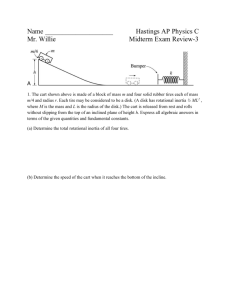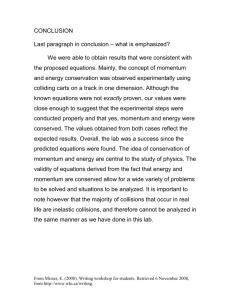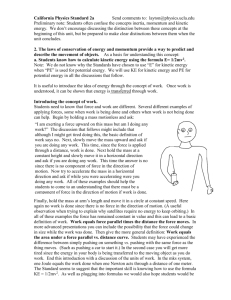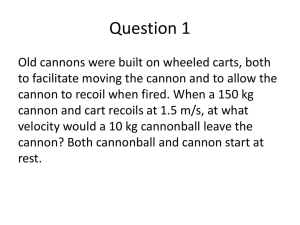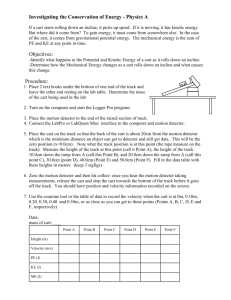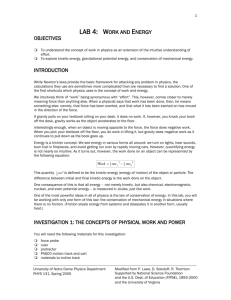Annotated Answers to the AP Physics 1 MT Rev 3 Multiple
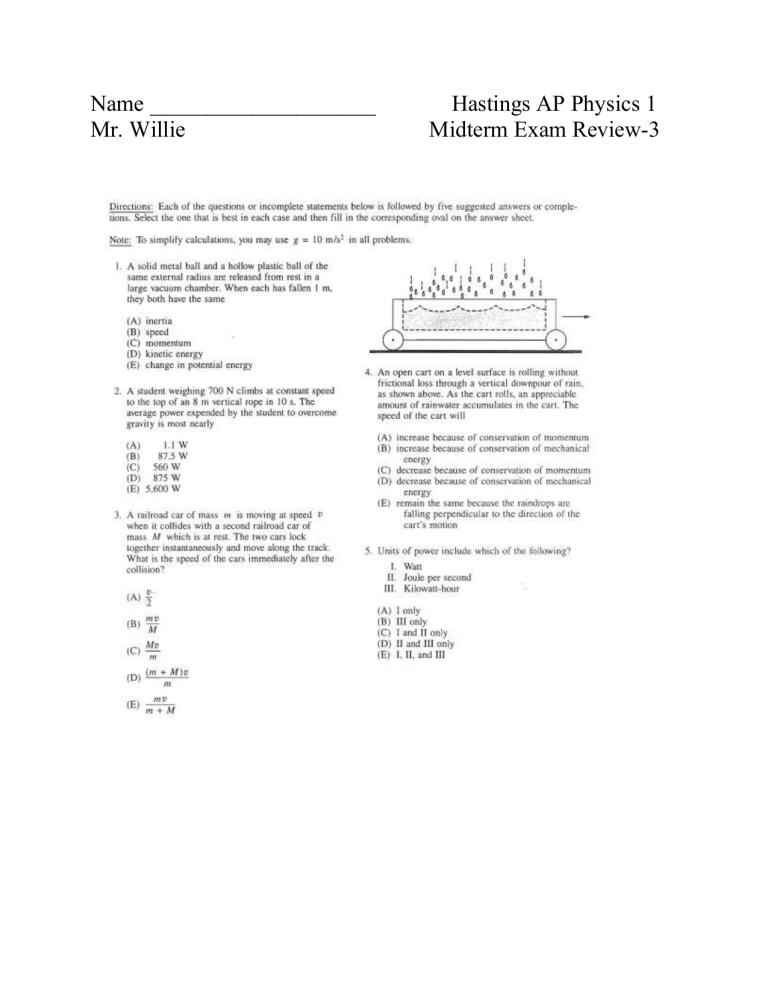
Name ____________________ Hastings AP Physics 1
Mr. Willie Midterm Exam Review-3
1. A small block of mass 0.15 kg is placed at point A at a height 2.0 m above the bottom of a track, as shown in the figure above, and is released from rest. It slides with negligible friction down the track, around the inside of the loop of radius 0.60 m, and leaves the track at point C at a height 0.50 m above the bottom of the track.
(a) Calculate the speed of the block when it leaves the track at point C .
(b) On the figure below, draw and label the forces (not components) that act on the block when it is at the top of the loop at point B .
1. continued
(c) Calculate the minimum speed the block can have at point B without losing contact with the track.
(d) Calculate the minimum height h min
above the bottom of the track at which the block can be released and still go around the loop without losing contact with the track.
2. You are to perform an experiment investigating the conservation of mechanical energy involving a transformation from initial gravitational potential energy to translational kinetic energy.
(a) You are given the equipment listed below, all the supports required to hold the equipment, and a lab table. On the list below, indicate each piece of equipment you would use by checking the line next to each item.
____ Track ____ Meterstick ____ Set of objects of different masses
____ Cart ____ Electronic balance ____ Lightweight low-friction pulley
____ String ____ Stopwatch
(b) Outline a procedure for performing the experiment. Include a diagram of your experimental setup. Label the equipment in your diagram. Also include a description of the measurements you would make and a symbol for each measurement.
(c) Give a detailed account of the calculations of gravitational potential energy and translational kinetic energy both before and after the transformation, in terms of the quantities measured in part (b).
2. (continued)
(d) After your first trial, your calculations show that the energy increased during the experiment. Assuming you made no mathematical errors, give a reasonable explanation for this result.
(e) On all other trials, your calculations show that the energy decreased during the experiment. Assuming you made no mathematical errors, give a reasonable physical explanation for the fact that the average energy you determined decreased. Include references to conservative and nonconservative forces, as appropriate.
Annotated Answers to the AP Physics 1 MT Rev 3 Multiple-Choice
1. B. The vacuum chamber removes air resistance. All objects fall with the same acceleration in the absence of air resistance, so at the end of one meter, each object has attained the same speed:
2a(x – xo) = v 2 – v o
2 .
2. C. Power = Work/time = mgh/t = (700 N)(8 m)/10 sec = 560 W. Note: 700 N = mg.
3. E. Conservation of momentum: mv = (m + M)V, or V = mv/(m + M).
4. C. The rain has no horizontal velocity before it lands in the cart. Once it lands in the cart, it gains horizontal velocity, so this must come from the horizontal velocity that the cart had before the rain fell in. The cart with its increased mass must slow down.
5. C. A Watt is a Joule/sec, so both are power. Kilowatt-hours are units of power times time; this is energy. (one kilowatt-hour is 3.6 megajoules)
Question 2
15 points total
(a) 1 point
For choosing the meterstick and stopwatch, regardless of what else is checked
(b) 4 points
Distribution of points
1 point
1 point For a procedure that indicates the height needed to calculate gravitational potential
Energy
For a procedure that indicates distance and time measurements to calculate velocity
For a diagram and a clear indication of the height measurement
For a diagram and a clear indication of the distance measurement
1 point
1 point
1 point
Example #1 m c m b h
H
Use the electronic balance to determine the mass m c
of the cart and the mass m b
of one object.
Attach the object to the cart using the string.
Place the cart on the track and hang the object so that the string passes through the pulley.
Allow the object to fall a distance h from its initial position to the floor, using the meterstick to measure the distance fallen.
Use the stopwatch to measure the time t it takes the object to fall the distance h .
Measure the height H of the table.
Question 2 (continued)
Distribution of points
(b) continued
Example #2 h d
Use the electronic balance to determine the mass m of the cart.
Set the track at an incline, and measure the height h of the incline.
Place the cart at the top of the incline, and release from rest.
Using the stopwatch, measure the time t it takes for the cart to move down the incline.
Measure the distance d that the cart moves down the incline.
(c) 6 points
For a clear indication of the initial potential energy of the system
For a clear indication of the final potential energy of the system
For a clear indication of the initial kinetic energy of the system
For a clear indication of the final kinetic energy of the system
For a correct calculation of the instantaneous velocity of the system
1 point
1 point
1 point
1 point
2 points
Example #1
Initial gravitational potential energy: U g 0
= m c gH + m b gh
Final gravitational potential energy: U gf
= m c gH
Initial kinetic energy: K
0
= 0
Final kinetic energy: K f
= ½(m c
+m b
)v f
2
Acceleration is constant, so d = 1/2(v o
+v f
)t, where d is the distance along the track. v f
= 2h/t
Question 2 (continued)
(c) continued
Example #2
Initial gravitational potential energy: Ug
0
= mgh
Final gravitational potential energy Ug f
= 0
Initial kinetic energy K
0
= 0
Final kinetic energy K
0
=1/2mv 2
Acceleration is constant, so d = ½(v o
+v f
)t v f
= 2d/t
(d) 2 points
For identifying a reasonable cause for the increase in energy
For a reasonable explanation related to the cause identified
Example
An unintentional push was applied to the cart, thus increasing the initial energy.
(e) 2 points
For identifying a reasonable cause for the decrease in energy related to the nonconservative forces acting on the system
For a reasonable explanation related to the cause identified
Example
Friction acting on the object decreases the speed, thereby decreasing the energy.
Distribution of points
1 point
1 point
1 point
1 point


